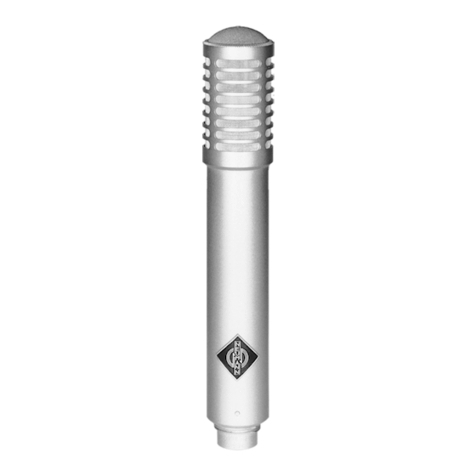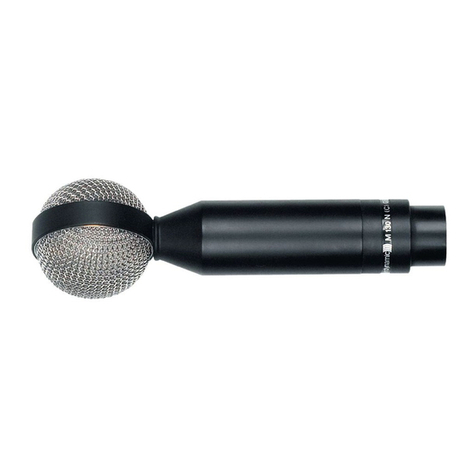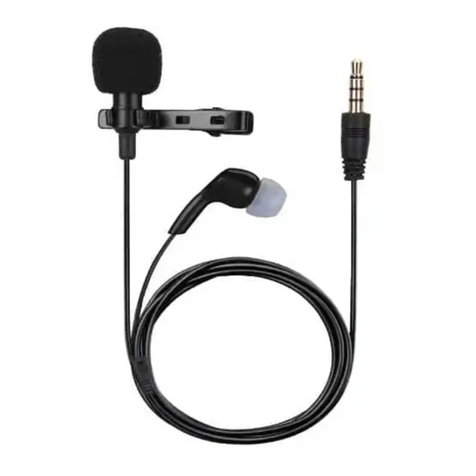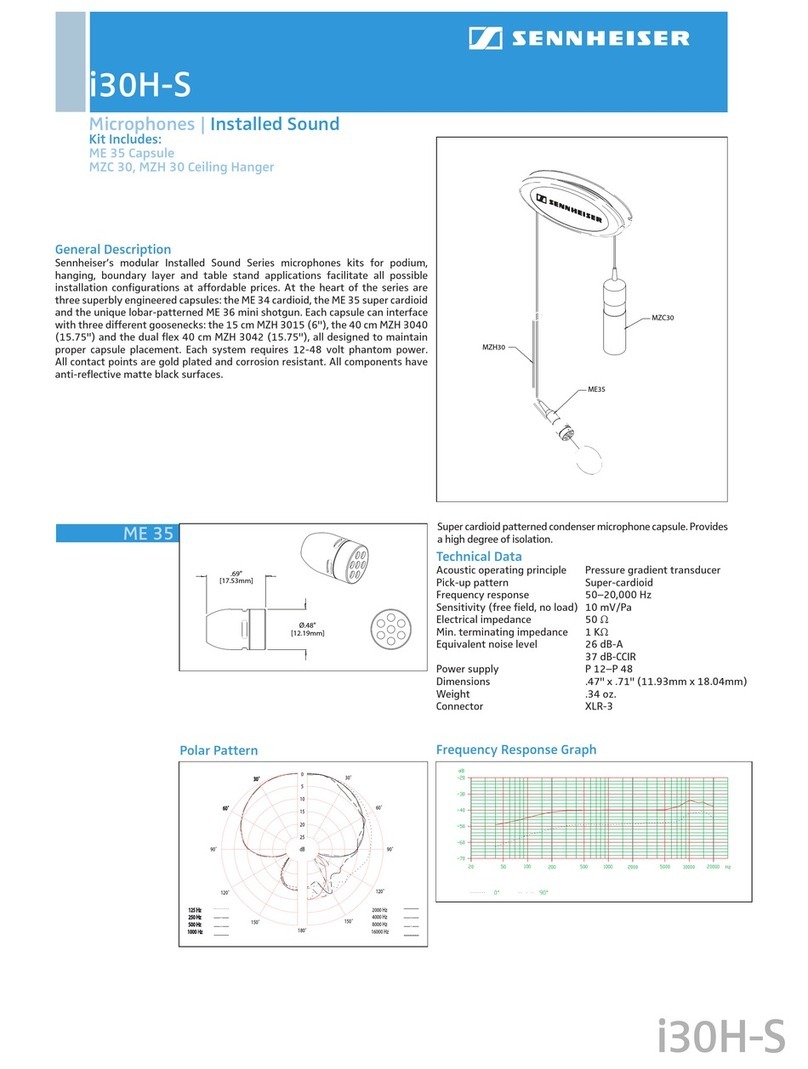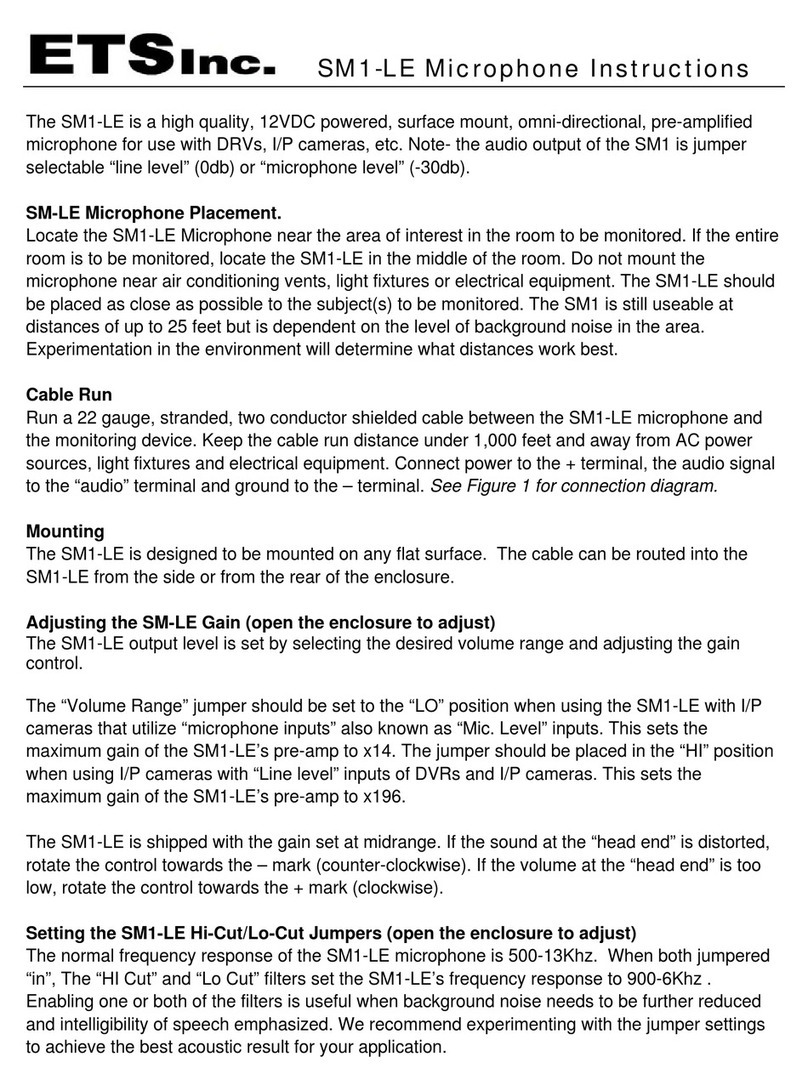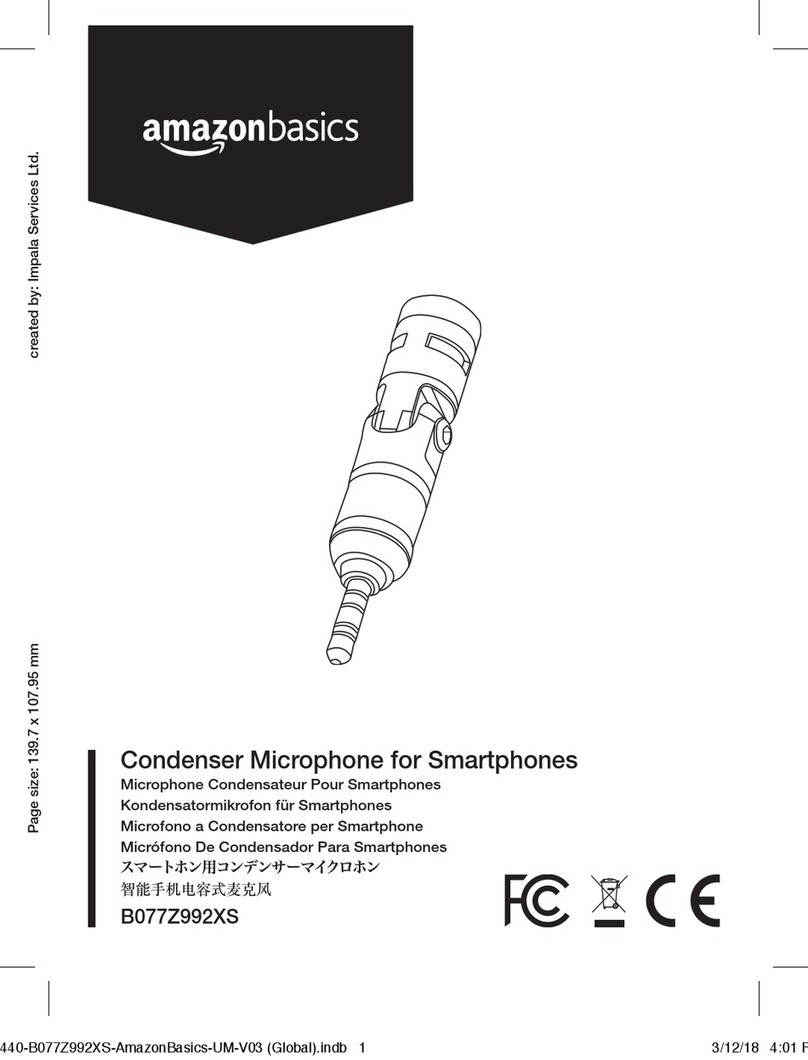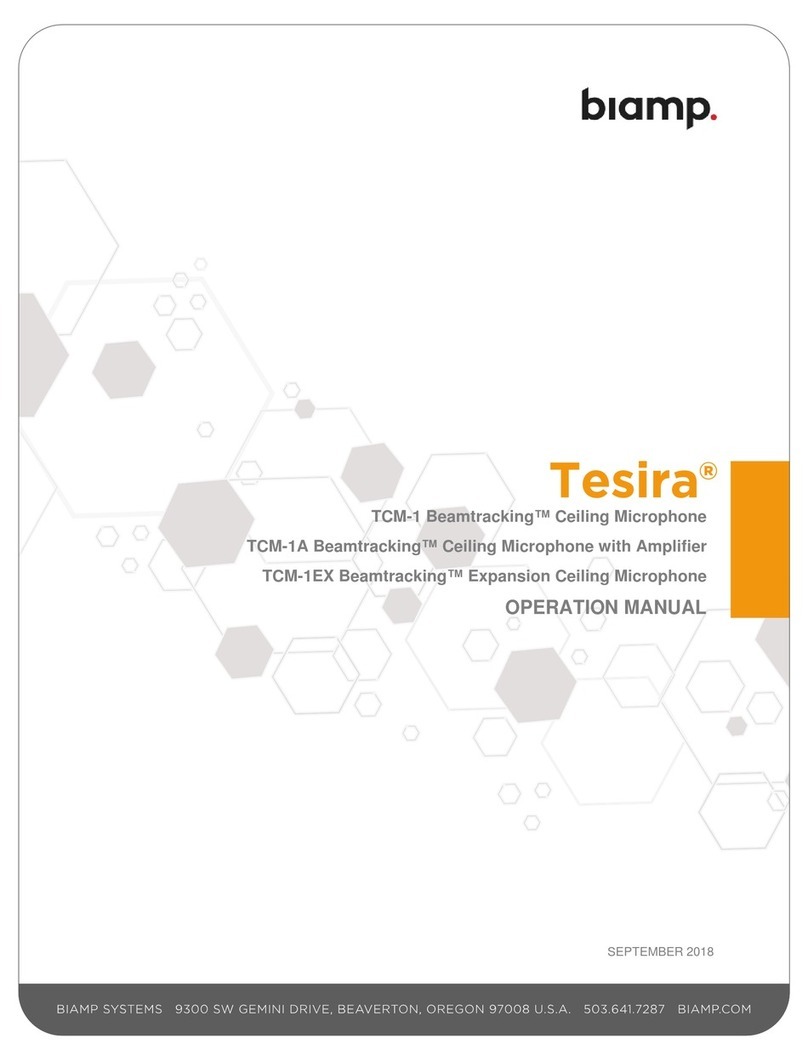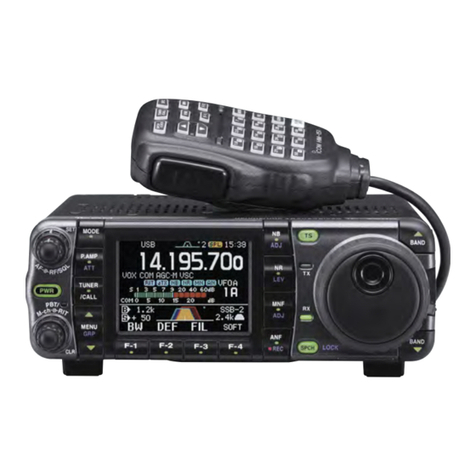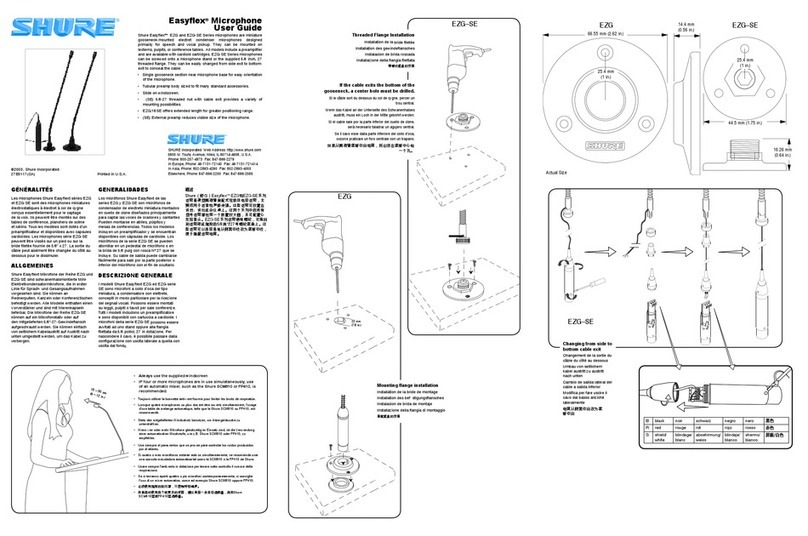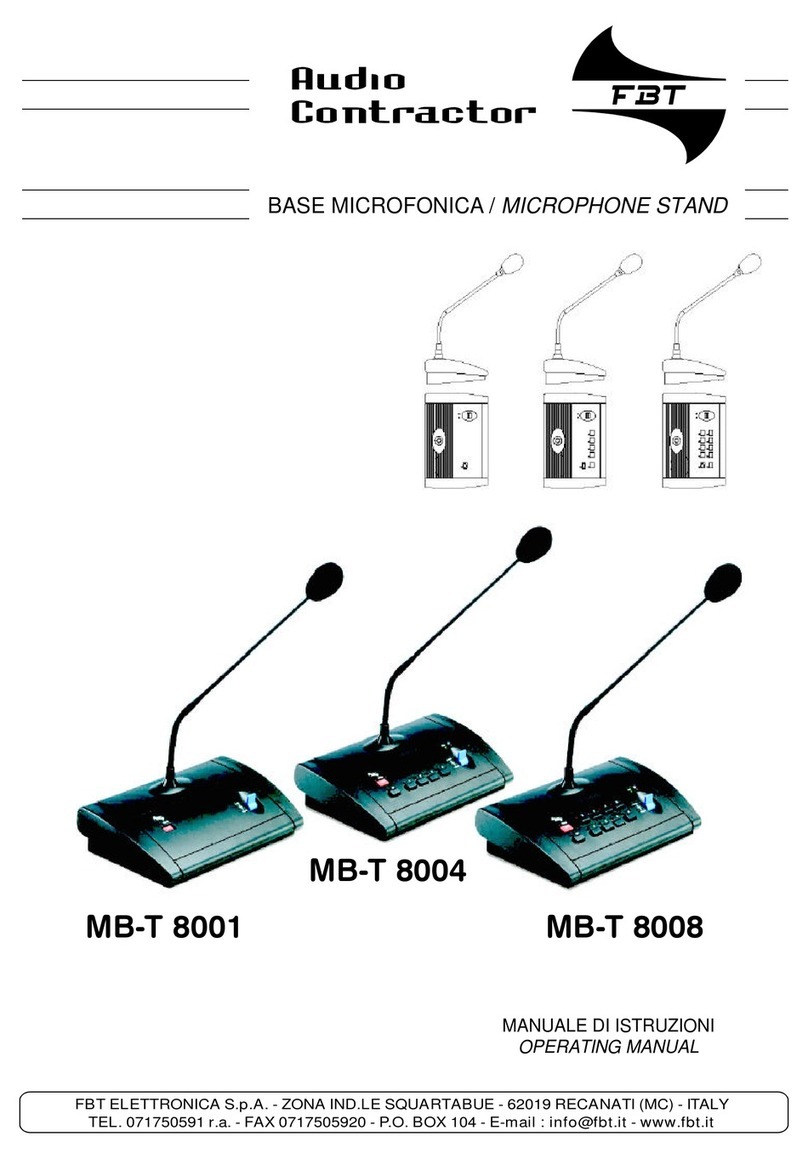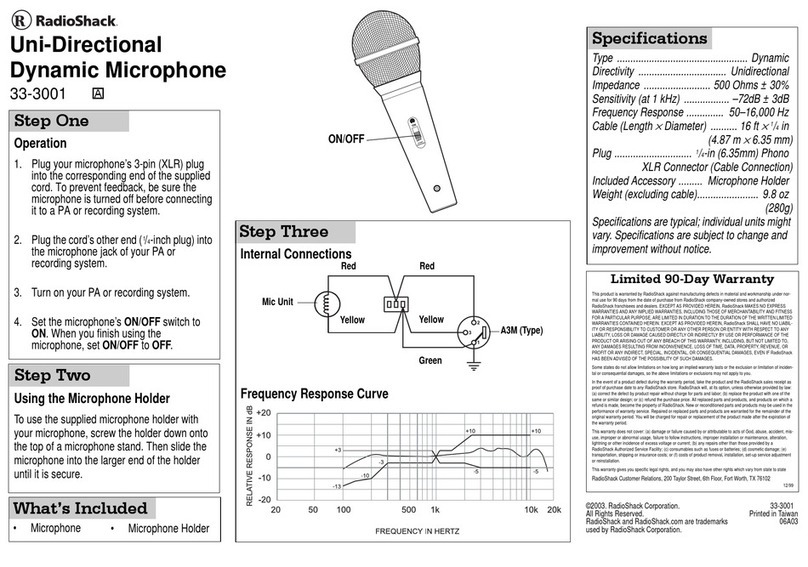Newskill KALIOPE User manual

GAMING CONDENSER MICROPHONE
QUICK GUIDE
KALIOPE

2
ENGLISH
TECHNICAL
SPECIFICATIONS
Model Newskill Kaliope
Dimensions 270mm 165x165 mm (with tripod)
188 x ø49 mm (microphone)
Weight 625g (microphone + holder + tripod + usb cable)
Connection type USB
Power input 5V-100mA
RGB Cycle/Fix colour
Cable Lenght 1,8m
Microphone
Type Electrec condenser
Condenser Type 14mm condensers
Polar pattern Cardioid
Antipop Filter Yes
Sample/Bitrate 48kHz / 16-Bit
Frequency response 30-18,000Hz
Sensitivity -36dB +/- 2dB (0dB = 1V / Pa at 1KHz)
Max. SPL 130dB
Headphone Output
Type 3,5mm jack
Sensitivity -36dB +/- 3dB
Impedance 32Ω
Frequency Range 20-20,000Hz
Monitoring Yes
ø49mm
270mm
188mm
165mm

3
ENGLISH
1
1 5
3 7
2 6
4 8
2
3
5
4
6
7
8
GENERAL OVERVIEW
USB port
Tripod
Headphone 3,5mm port
Headphone volumen knob
LED mode (press)
Gain knob
Mute button
Antipop filter
USB cable

4
ENGLISH
Polarity pattern:
Cardioid
Cardioid microphones are unidirectional microphones with
a cardioid polar pattern, which means a higher sensitivity to
sounds coming from the front and, on the contrary, a minimum
sensitivity to sounds coming from the rear, where a gradual
attenuation takes place.
This heart shape is obtained by leaving the diaphragm free
at the front and building acoustic labyrinths at the back.
Cardiod microphones offer the best frequency response at mid frequencies. The bass is more dispersed,
while the high frequencies become more directional.
As the cardioid mic can reach a preferred angle of 181°, they are ideal for general sound pick-up from a
frontal point of view. In addition, cardioid mics support spaced sources, unlike two-way mics.
One thing to note about cardioid mics, however, is that feedback can occur if there is a rear-firing
loudspeaker.
Cardioid polarity pattern is recommended for use in podcasting, streaming, voice recording, etc.
FUNCTIONAL
DESCRIPTION

5
ENGLISH
Gain
In a microphone, gain can usually be described as its sensitivity. Increasing the gain will increase the
sensitivity of your microphone and allow you to pick up lower sounds.
Considering the nature of gain, and that it is the strength of the input signal, altering the gain begins to
affect the recording volume at specific thresholds. Furthermore, gain can affect the recording volume
because it is the input strength, but volume cannot affect gain because it is the output strength.
Since volume changes the strength of a signal after it has been processed, changing the volume does
not affect the tone itself and only alters its loudness.
Gain on the other hand is the input dB and therefore gain alters the strength of a signal before it is
processed. This means that changing the gain changes the signals that the audio device works with and
processes. Therefore, gain can make a difference to the very characteristics of a sound.
To adjust the gain, simply turn the first "GAIN" knob to the left or right.
FUNCTIONAL
DESCRIPTION

6
ENGLISH
RGB lighting function
The RGB lighting function is activated by pressing the "GAIN" button and you can select the following
colours/effects
The lighting function has no memory, so it will return to the initial position each time it is switched on.
RAINBOW RGB
OFF BLUE
YELLOW
RED
GREENPURPLE
FUNCTIONAL
DESCRIPTION

7
ENGLISH
INSTALLATION
To use Kaliope fully, insert the USB cable into the PC and its corresponding connector into the
microphone. You will be able to control its functions by means of the built-in buttons as well as being
able to control its additional values by means of the operating system and/or additional software (OBS,
Streamlabs, Audacity...).
Kaliope does not require additional software to work.

8
ENGLISH
To ensure that Kaliope is configured correctly, please follow these steps
In Windows 10/11 go to System > Sound and
select Kaliope in the input section.
If we click on the right arrow we can enter the
properties and set it as default use and control the
volume (not gain) of the microphone.
INSTALLATION

9
ENGLISH
MONITORING FUNCTION
/ HEADPHONES
If we connect headphones to the built-in output, we can have a monitoring function, i.e. we can listen
both to what is played on the PC and to what is picked up by the microphone. To control the volume of
the microphone, just use the wheel integrated in the microphone.
This function is very useful to detect if we are talking too loud or too quiet, highly recommended
for online games and for streaming or podcasting, it helps us to maintain a regular tone although
it may experience some discomfort when using it the first few times.

10
FRANÇAIS
SPÉCIFICATIONS
TECHNIQUES
Modèle Newskill Kaliope
Dimensions 270mm 165x165 mm (with tripod)
188 x ø49 mm (microphone)
Poids 625g (microphone + pied + trépied + câble USB)
Type de connexion USB
Alimentation électrique 5V-100mA
RGB Couleur du cycle/xe
Longueur du câble 1,8m
Microphone
Type Microphone à condensateur à électret
Type de condenseur Condenseur de 14 mm
Polarité Cardioïde
Filtre anti-pop Oui
Échantillonnage 48kHz / 16-Bit
Réponse en fréquence 30-18,000Hz
Sensibilité -36dB +/- 2dB (0dB = 1V / Pa à 1KHz)
SPL max. 130dB
Sortie casque
Type Prise jack 3,5 mm
Sensibilité -36dB +/- 3dB
Impédance 32Ω
Gamme de fréquences 20-20,000Hz
Fonction de surveillance Oui
ø49mm
270mm
188mm
165mm

11
FRANÇAIS
1
1 5
3 7
2 6
4 8
2
3
5
4
6
7
8
APERÇU GÉNÉRAL
Port USB
Trépied
Port casque 3,5 mm
Bouton de volume du casque
Mode LED (appuyer)
Bouton de gain
Bouton de sourdine
Filtre anti-pop
Câble USB

12
FRANÇAIS
Modèle de polarité :
Cardioïde
Les microphones cardioïdes sont des microphones
unidirectionnels avec une directivité cardioïde, ce qui signifie
une sensibilité plus élevée aux sons provenant de l'avant et,
au contraire, une sensibilité minimale aux sons provenant de
l'arrière, où une atténuation progressive a lieu.
Cette forme de cœur est obtenue en laissant le diaphragme
libre à l'avant et en construisant des labyrinthes acoustiques à l'arrière.
Les microphones Cardiod offrent la meilleure réponse en fréquence aux fréquences moyennes. Les basses
sont plus dispersées, tandis que les hautes fréquences deviennent plus directionnelles.
Comme les micros cardioïdes peuvent atteindre un angle privilégié de 181°, ils sont idéaux pour la prise
de son générale d'un point de vue frontal. En outre, les micros cardioïdes prennent en charge les sources
espacées, contrairement aux micros à deux voies.
Une chose à noter à propos des micros cardioïdes, cependant, est qu'un larsen peut se produire s'il y a un
haut-parleur à l'arrière. Le modèle de polarité cardioïde est recommandé pour une utilisation en podcasting,
streaming, enregistrement vocal, etc.
DESCRIPTION
FONCTIONNELLE

13
FRANÇAIS
Gain
Dans un microphone, le gain peut généralement être décrit comme sa sensibilité. En augmentant le
gain, vous augmenterez la sensibilité de votre microphone et vous pourrez capter des sons plus graves.
Compte tenu de la nature du gain, et du fait qu'il s'agit de la force du signal d'entrée, la modification
du gain commence à affecter le volume d'enregistrement à des seuils spécifiques. De plus, le gain peut
affecter le volume d'enregistrement car il s'agit de la force d'entrée, mais le volume ne peut pas affecter
le gain car il s'agit de la force de sortie.
Puisque le volume modifie la force d'un signal après qu'il ait été traité, la modification du volume
n'affecte pas le son lui-même et ne modifie que son intensité.
Le gain, quant à lui, est le dB d'entrée et modifie donc la force d'un signal avant qu'il ne soit traité.
Cela signifie que la modification du gain change les signaux que l'appareil audio traite et utilise. Par
conséquent, le gain peut faire une différence dans les caractéristiques mêmes d'un son.
Pour régler le gain, il suffit de tourner le premier bouton "GAIN" vers la gauche ou la droite.
DESCRIPTION
FONCTIONNELLE

14
FRANÇAIS
Fonction d'éclairage RGB
La fonction d'éclairage RGB est activée en appuyant sur le bouton "GAIN" et vous pouvez sélectionner
les couleurs/effets suivants
La fonction d'éclairage n'a pas de mémoire, elle revient donc à la position initiale à chaque fois qu'elle est
allumée.
RGB
OFF BLEU
JAUNE
ROUGE
VERTVIOLET
DESCRIPTION
FONCTIONNELLE

15
FRANÇAIS
INSTALLATION
Pour utiliser pleinement Kaliope, insérez le câble USB dans le PC et son connecteur correspondant dans
le microphone. Vous pourrez contrôler ses fonctions à l'aide des boutons intégrés ainsi que ses valeurs
additionnelles à l'aide du système d'exploitation et/ou de logiciels supplémentaires (OBS, Streamlabs,
Audacity...).
Kaliope ne nécessite pas de logiciel supplémentaire pour fonctionner.

16
FRANÇAIS
Pour vous assurer que Kaliope est configuré correctement, veuillez suivre les étapes suivantes
Sous Windows 10/11, allez dans Système > Son et
sélectionnez Kaliope dans la section entrée.
Si nous cliquons sur la flèche droite, nous pouvons
entrer dans les propriétés et le définir comme
utilisation par défaut et contrôler le volume (pas le
gain) du microphone.
INSTALLATION

17
FRANÇAIS
FONCTION D'ÉCOUTE
/CASQUE
Si nous connectons un casque à la sortie intégrée, nous pouvons avoir une fonction de monitoring, c'est-
à-dire que nous pouvons écouter à la fois ce qui est joué sur le PC et ce qui est capté par le microphone.
Pour contrôler le volume du microphone, il suffit d'utiliser la molette intégrée au microphone.
Cette fonction est très utile pour détecter si nous parlons trop fort ou trop bas, fortement
recommandée pour les jeux en ligne et pour le streaming ou le podcasting, elle nous aide à
maintenir un ton régulier bien qu'elle puisse éprouver un certain inconfort lors de son utilisation
les premières fois.

18
DEUTSCH
TECHNISCHE
SPEZIFIKATIONEN
Modell Newskill Kaliope
Abmessungen 270mm 165x165 mm (with tripod)
188 x ø49 mm (microphone)
Gewicht 625g (Mikrofon + Ständer + Stativ + USB-Kabel)
Verbindungstyp USB
Stromversorgung 5V-100mA
RGB Cycle/Fix Farbe
Länge des Kabels 1,8m
Mikrofon
Typ Elektret-Kondensatormikrofon
Typ Verflüssiger 14-mm-Kondensator
Polarität Kardioide
Anti-Pop-Filter Ja
Probenahme 48kHz / 16-Bit
Frequenzgang 30-18,000Hz
Empfindlichkeit -36dB +/- 2dB (0dB = 1V / Pa bei 1KHz)
Max. SPL 130dB
Kopfhörerausgang
Typ 3,5-mm-Buchse
Empfindlichkeit -36dB +/- 3dB
Impedanz 32Ω
Frequenzbereich 20-20,000Hz
Funktion überwachen Ja
ø49mm
270mm
188mm
165mm

19
DEUTSCH
1
1 5
3 7
2 6
4 8
2
3
5
4
6
7
8
ALLGEMEINE ÜBERSICHT
USB-Anschluss
Stativ
Kopfhörer 3,5mm Anschluss
Kopfhörer-Volumenknopf
LED-Modus (drücken)
Gain-Knopf
Stummschalttaste
Antipop-Filter
USB-Kabel

20
DEUTSCH
Richtcharakteristik:
Niere
Nierenmikrofone sind unidirektionale Mikrofone mit
nierenförmiger Richtcharakteristik, d. h. mit höherer
Empfindlichkeit für Töne, die von vorne kommen, und im
Gegensatz dazu geringerer Empfindlichkeit für Töne, die von
hinten kommen, wo eine allmähliche Dämpfung stattfindet.
Diese Herzform wird dadurch erreicht, dass die Membran
vorne frei bleibt und hinten akustische Labyrinthe gebildet werden.
Kardiod-Mikrofone bieten den besten Frequenzgang bei mittleren Frequenzen. Die Bässe sind breiter
gestreut, während die hohen Frequenzen stärker gerichtet sind.
Da das Nierenmikrofon einen bevorzugten Winkel von 181° erreichen kann, sind sie ideal für die allgemeine
Schallabnahme von vorne. Darüber hinaus unterstützen Nierenmikrofone im Gegensatz zu Zweiwege-
Mikrofonen auch entfernte Quellen.
Bei Nierenmikrofonen ist jedoch zu beachten, dass es zu Rückkopplungen kommen kann, wenn ein
rückwärtig abstrahlender Lautsprecher vorhanden ist. Die Nieren-Richtcharakteristik wird für Podcasting,
Streaming, Sprachaufnahmen usw. empfohlen.
FUNKTIONSBESCHREIBUNG
Table of contents
Languages:
Other Newskill Microphone manuals

